Nanosphere Lithography on Fiber: Towards Engineered Lab-On-Fiber SERS Optrodes
Abstract
:1. Introduction
2. Materials and Methods
2.1. SERS Substrate Fabrication by Nanosphere Lithography
2.2. Spectral Characterizations
2.3. Biphenyl-4-Thiol Sample Preparation
2.4. Raman and SERS Measurements
2.5. Fiber Probe Selection
3. Results and Discussion
3.1. SERS Structure Performances
3.2. Fiber Probe Performances
4. Conclusions
Author Contributions
Conflicts of Interest
References
- Raman, C.V.; Krishnan, K.S. A new type of secondary radiation. Nature 1928, 121, 501–502. [Google Scholar] [CrossRef]
- Shipp, D.W.; Sinjab, F.; Notingher, I. Raman spectroscopy: Techniques and applications in the life sciences. Adv. Opt. Photon. 2017, 9, 315–428. [Google Scholar] [CrossRef]
- Neugebauer, U.; Heinemann, S.H.; Schmitt, M.; Popp, J. Combination of patch clamp and Raman spectroscopy for single-cell analysis. Anal. Chem. 2011, 83, 344–350. [Google Scholar] [CrossRef] [PubMed]
- Jonas, A.; de Luca, A.C.; Pesce, G.; Rusciano, G.; Sasso, A.; Caserta, S.; Guido, S.; Marrucci, G. Diffusive mixing of polymers investigated by Raman microspectroscopy and microrheology. Langmuir 2010, 26, 14223–14230. [Google Scholar] [CrossRef] [PubMed]
- De Luca, A.C.; Managó, S.; Ferrara, M.A.; Rendina, I.; Sirleto, L.; Puglisi, R.; Balduzzi, D.; Galli, A.; Ferraro, P.; Coppola, G. Non-invasive sex assessment in bovine semen by Raman spectroscopy. Laser Phys. Lett. 2014, 11, 055604. [Google Scholar] [CrossRef]
- Jermyn, M.; Desroches, J.; Aubertin, K.; St-Arnaud, K.; Madore, W.J.; De Montigny, E.; Guiot, M.C.; Trudel, D.; Wilson, B.C.; Petrecca, K.; et al. A review of Raman spectroscopy advances with an emphasis on clinical translation challenges in oncology. Phys. Med. Biol. 2016, 61, R370–R400. [Google Scholar] [CrossRef] [PubMed]
- Managò, S.; Valente, C.; Mirabelli, P.; Circolo, D.; Basile, F.; Corda, D.; de Luca, A.C. A reliable Raman-spectroscopy-based approach for diagnosis, classification and follow-up of B-cell acute lymphoblastic leukemia. Sci. Rep. 2016, 6. [Google Scholar] [CrossRef] [PubMed]
- Wang, H.; Lee, A.M.D.; Lui, H.; McLean, D.I.; Zeng, H. A method for accurate in vivo micro-Raman spectroscopic measurements under guidance of advanced microscopy imaging. Sci. Rep. 2013, 3, 1890. [Google Scholar] [CrossRef] [PubMed]
- Managò, S.; Migliaccio, N.; Terracciano, M.; Napolitano, M.; Martucci, N.M.; De Stefano, L.; Rendina, I.; De Luca, A.C.; Lamberti, A.; Rea, I. Internalization kinetics and cytoplasmic localization of functionalized diatomite nanoparticles in cancer cells by Raman imaging. J. Biophotonics 2017. [Google Scholar] [CrossRef] [PubMed]
- Santos, L.F.; Wolthuis, R.; Koljenović, S.; Almeida, R.M.; Puppels, G.J. Fiber-optic probes for in vivo Raman spectroscopy in the high-wavenumber region. Anal. Chem. 2005, 77, 6747–6752. [Google Scholar] [CrossRef] [PubMed]
- Motz, J.T.; Hunter, M.; Galindo, L.H.; Gardecki, J.A.; Kramer, J.R.; Dasari, R.R.; Feld, M.S. Optical fiber probe for biomedical Raman spectroscopy. Appl. Opt. 2004, 43, 542–554. [Google Scholar] [CrossRef] [PubMed]
- Dochow, S.; Ma, D.; Latka, I.; Bocklitz, T.; Hartl, B.; Bec, J.; Fatakdawala, H.; Marple, E.; Urmey, K.; Wachsmann-Hogiu, S.; et al. Combined fiber probe for fluorescence lifetime and Raman spectroscopy. Anal. Bioanal. Chem. 2015, 407, 8291–8301. [Google Scholar] [CrossRef] [PubMed]
- Jermyn, M.; Mercier, J.; Aubertin, K.; Desroches, J.; Urmey, K.; Karamchandiani, J.; Marple, E.; Guiot, M.C.; Leblond, F.; Petrecca, K. Highly accurate detection of cancer in situ with intraoperative, label-free, multimodal optical spectroscopy. Cancer Res. 2017, 77, 3942–3950. [Google Scholar] [CrossRef] [PubMed]
- De Luca, A.C.; Dholakia, K.; Mazilu, M. Modulated Raman spectroscopy for enhanced cancer diagnosis at the cellular level. Sensors 2015, 15, 13680–13704. [Google Scholar] [CrossRef] [PubMed] [Green Version]
- De Luca, A.C.; Reader-Harris, P.; Mazilu, M.; Mariggiò, S.; Corda, D.; Di Falco, A. Reproducible surface-enhanced Raman quantification of biomarkers in multicomponent mixtures. ACS Nano 2014, 8, 2575–2583. [Google Scholar] [CrossRef] [PubMed] [Green Version]
- Stoddart, P.R.; White, D.J. Optical fibre SERS sensors. Anal. Bioanal. Chem. 2009, 394, 1761. [Google Scholar] [CrossRef] [PubMed]
- Kostovski, G.; Stoddart, P.R.; Mitchell, A. The optical fiber tip: An inherently light-coupled microscopic platform for micro- and nanotechnologies. Adv. Mater. 2014, 26, 3798–3820. [Google Scholar] [CrossRef] [PubMed]
- Viets, C.; Hill, W. Comparison of fibre-optic SERS sensors with differently prepared tips. Sens. Actuators B Chem. 1998, 51, 92–99. [Google Scholar] [CrossRef]
- Stokes, D.L.; Vo-Dinh, T. Development of an integrated single-fiber. Sens. Actuators B Chem. 2000, 69, 28–36. [Google Scholar] [CrossRef]
- Polwart, E.; Keir, R.L.; Davidson, C.M.; Smith, W.E.; Sadler, D.A. Novel SERS-active optical fibers prepared by the immobilization of silver colloidal particles. Appl. Spectrosc. 2000, 54, 522–527. [Google Scholar] [CrossRef]
- Ricciardi, A.; Crescitelli, A.; Vaiano, P.; Quero, G.; Consales, M.; Pisco, M.; Esposito, E.; Cusano, A. Lab-on-Fiber Technology: A New Vision for Chemical and Biological Sensing. Analyst 2015, 140, 8079. [Google Scholar] [CrossRef] [PubMed]
- Vaiano, P.; Carotenuto, B.; Pisco, M.; Ricciardi, A.; Giuseppe, Q.; Consales, M.; Crescitelli, A.; Esposito, E.; Cusano, A. Lab on Fiber Technology for biological sensing applications. Laser Photonics Rev. 2016, 10, 922. [Google Scholar] [CrossRef]
- Kostovski, G.; White, D.J.; Mitchell, A.; Austin, M.W.; Stoddart, P.R. Nanoimprinted optical fibres: Biotemplated nanostructures for SERS sensing. Biosens. Bioelectron. 2009, 24, 1531–1535. [Google Scholar] [CrossRef] [PubMed]
- Smythe, E.J.; Dickey, M.D.; Bao, J.; Whitesides, G.M.; Capasso, F. Optical antenna arrays on a fiber facet for in situ surface-enhanced Raman scattering detection. Nano Lett. 2009, 9, 1132–1138. [Google Scholar] [CrossRef] [PubMed]
- Bouvrée, A. Nanostructured and nanopatterned gold surfaces: Application to the surface-enhanced Raman spectroscopy. Gold Bull. 2013, 46, 283–290. [Google Scholar] [CrossRef]
- Andrade, G.F.S.; Hayashi, J.G.; Cordeiro, C.M.B.; Rahman, M.M.; Brolo, A.G. Surface-enhanced resonance Raman scattering (SERRS) using Au nanohole arrays on optical fiber tips. Plasmonics 2013, 8, 1113–1121. [Google Scholar] [CrossRef]
- Wang, C.; Zeng, L.; Li, Z.; Li, D. Review of optical fibre probes for enhanced Raman sensing. J. Raman Spectrosc. 2017, 48, 1040–1055. [Google Scholar] [CrossRef]
- Andrade, G.F.S.; Fan, M.; Brolo, A.G. Multilayer silver nanoparticles-modified optical fiber tip for high performance SERS remote sensing. Biosens. Bioelectron. 2010, 25, 2270–2275. [Google Scholar] [CrossRef] [PubMed]
- Yap, F.L.; Thoniyot, P.; Krishnan, S.; Krishnamoorthy, S. Nanoparticle cluster arrays for high-performance SERS through directed self-assembly on flat substrates and on optical fibers. ACS Nano 2012, 6, 2056–2070. [Google Scholar] [CrossRef] [PubMed]
- Jayawardhana, S.; Mazzolini, A.P.; Stoddart, P.R. Collection efficiency of scattered light in single-ended optical fiber sensors. Opt. Lett. 2012, 37, 2142–2144. [Google Scholar] [CrossRef] [PubMed]
- Hartley, J.S.; Juodkazis, S.; Stoddart, P.R. Optical fibers for miniaturized surface-enhanced Raman-scattering probes. Appl. Opt. 2013, 52, 8388–8393. [Google Scholar] [CrossRef] [PubMed]
- Yang, X.; Shi, C.; Newhouse, R.; Zhang, J.Z.; Gu, C. Hollow-Core Photonic Crystal Fibers for Surface-Enhanced Raman Scattering Probes. Int. J. Opt. 2011, 2011. [Google Scholar] [CrossRef]
- Cooney, T.F.; Schoen, C.L.; Sharma, S.K.; Carey, D.M. Rare-earth-doped glass fiber for background rejection in remote fiber-optic Raman probes: Theory and analysis of holmium-bearing glas. Appl. Spectrosc. 1993, 47, 1683–1692. [Google Scholar] [CrossRef]
- Raml, C.; He, X.; Han, M.; Alexander, D.R.; Lu, Y. Raman spectroscopy based on a single-crystal sapphire fiber. Opt. Lett. 2011, 36, 1287–1289. [Google Scholar] [CrossRef] [PubMed]
- Chen, H.; Tian, F.; Chi, J.; Kanka, C.J.; Du, H. Advantage of multi-mode sapphire optical fiber for evanescent-field SERS sensing. Opt. Lett. 2014, 39, 5822–5825. [Google Scholar] [CrossRef] [PubMed]
- Chen, H.; Tian, F.; Chi, J.; Du, H. Sapphire fiber optic-based surface-enhanced Raman scattering by direct and evanescent-field excitation. Proc. SPIE 2014, 90980. [Google Scholar] [CrossRef]
- Latka, I.; Dochow, S.; Krafft, C.; Dietzek, B.; Popp, J. Fiber optic probes for linear and nonlinear Raman applications–Current trends and future development. Laser Photonics Rev. 2013, 7, 698–731. [Google Scholar] [CrossRef]
- Pisco, M.; Galeotti, F.; Quero, G.; Iadicicco, A.; Giordano, M.; Cusano, A. Miniaturized sensing probes based on metallic dielectric crystals self-assembled on optical fiber tips. ACS Photonics 2014, 1, 917–927. [Google Scholar] [CrossRef]
- Pisco, M.; Galeotti, F.; Grisci, G.; Quero, G.; Cusano, A. Self-assembled periodic patterns on the optical fiber tip by microsphere arrays. In Proceedings of the 24th International Conference on Optical Fibre Sensors, Curitiba, Brazil, 28 September–2 October 2015; Kalinowski, H.J., Fabris, J.L., Bock, W.J., Eds.; SPIE: Bellingham, WA, USA, 2015. [Google Scholar]
- Pisco, M.; Galeotti, F.; Quero, G.; Grisci, G.; Micco, A.; Mercaldo, L.; Veneri, P.D.; Cusano, A. Nanosphere lithography for advanced all fiber Sers probes. In Proceedings of the Sixth European Workshop on Optical Fibre Sensors, Limerick, Ireland, 31 May–3 June 2016; Lewis, E., Ed.; SPIE: Bellingham, WA, USA. [Google Scholar]
- Pisco, M.; Galeotti, F.; Quero, G.; Grisci, G.; Micco, A.; Mercaldo, L.V.; Delli Veneri, P.; Cutolo, A.; Cusano, A. Nanosphere lithography for optical fibre tip nanoprobes. Light Sci. Appl. 2017, 6, e16229. [Google Scholar] [CrossRef]
- Vericat, C.; Vela, M.E.; Benitez, G.; Carro, P.; Salvarezza, R.C. Self-assembled monolayers of thiols and dithiols on gold: New challenges for a well-known system. Chem. Soc. Rev. 2010, 39, 1805–1834. [Google Scholar] [CrossRef] [PubMed]
- Hinterwirth, H.; Kappel, S.; Waitz, T.; Prohaska, T.; Lindner, W.; Lammerhofer, M. Quantifying Thiol Ligand Density of Self-Assembled Monolayers on Gold Nanoparticles by Inductively Coupled Plasma–Mass Spectrometry. ACS Nano 2013, 7, 1129–1136. [Google Scholar] [CrossRef] [PubMed]
- Specsheet of the Optical Fiber FG050LCA THORLABS. Available online: https://www.thorlabs.com/drawings/6db478e019d5b268-665A608D-01FC-1109-838544C8192651B8/FG050LGA-SpecSheet.pdf (accessed on 19 February 2018).
- Specsheet of the Optical Fiber FG105LCA THORLABS. Available online: https://www.thorlabs.com/drawings/6db478e019d5b268-665A608D-01FC-1109-838544C8192651B8/FG105LCA-SpecSheet.pdf (accessed on 19 February 2018).
- Specsheet of the Optical Fiber FP200ERT THORLABS. Available online: https://www.thorlabs.com/drawings/6db478e019d5b268-665A608D-01FC-1109-838544C8192651B8/FP200ERT-SpecSheet.pdf (accessed on 19 February 2018).
- Specsheet of the Optical Fiber FP400ERT THORLABS. Available online: https://www.thorlabs.com/drawings/6db478e019d5b268-665A608D-01FC-1109-838544C8192651B8/FP400ERT-SpecSheet.pdf (accessed on 19 February 2018).
- Benz, F.; Chikkaraddy, R.; Salmon, A.; Ohadi, H.; de Nijs, B.; Mertens, J.; Carnegie, C.; Bowman, R.W.; Baumberg, J.J. SERS of individual nanoparticles on a mirror: Size does matter, but so does shape. J. Phys. Chem. Lett. 2016, 7, 2264–2269. [Google Scholar] [CrossRef] [PubMed]
- Zito, G.; Rusciano, G.; Pesce, G.; Dochshanov, A.; Sasso, A. Surface-enhanced Raman imaging of cell membrane by a highly homogeneous and isotropic silver nanostructure. Nanoscale 2015, 7, 8593–8606. [Google Scholar] [CrossRef] [PubMed]
- Haynes, C.L.; Van Duyne, R.P. Nanosphere lithography: A versatile nanofabrication tool for studies of size-dependent nanoparticle optics. J. Phys. Chem. B 2001, 105, 5599–5611. [Google Scholar] [CrossRef]
- Hong, S.; Xiao, L. Optimal size of gold nanoparticles for surface-enhanced Raman spectroscopy under different conditions. J. Nanomater. 2013, 2013. [Google Scholar] [CrossRef]
- Sharma, B.; Cardinal, M.F.; Kleinman, S.L.; Greeneltch, N.G.; Frontiera, R.R.; Blaber, M.G.; Schatz, G.C.; van Duyne, R.P. High-performance SERS substrates: Advances and challenges. MRS Bull. 2013, 38, 615–624. [Google Scholar] [CrossRef]
- Mosier-Boss, P.A. Review of SERS Substrates for Chemical Sensing. Nanomaterials 2017, 7, 142. [Google Scholar] [CrossRef] [PubMed]
- Vendrell, M.; Maiti, K.K.; Dhaliwal, K.; Chang, Y. Surface-enhanced Raman scattering in cancer detection and imaging. Trends Biotechnol. 2013, 31, 249–257. [Google Scholar] [CrossRef] [PubMed]
- Kalbacova, J.; Rodriguez, R.D.; Desale, V.; Schneider, M.; Amin, I.; Jordan, R.; Zahn, D.R.T. Chemical stability of plasmon-active silver tips for tip-enhanced Raman spectroscopy. Nanospectroscopy 2014, 1, 12–18. [Google Scholar] [CrossRef]
- May, J.; Li, Y.S. Fiber Raman background study and its application in setting up optical fiber Raman probes. Appl. Opt. 1996, 35, 2527–2533. [Google Scholar] [CrossRef] [PubMed]
- Komachi, Y.; Sato, H.; Aizawa, K.; Tashiro, H. Micro-optical fiber probe for use in an intravascular Raman endoscope. Appl. Opt. 2005, 44, 4722–4732. [Google Scholar] [CrossRef] [PubMed]
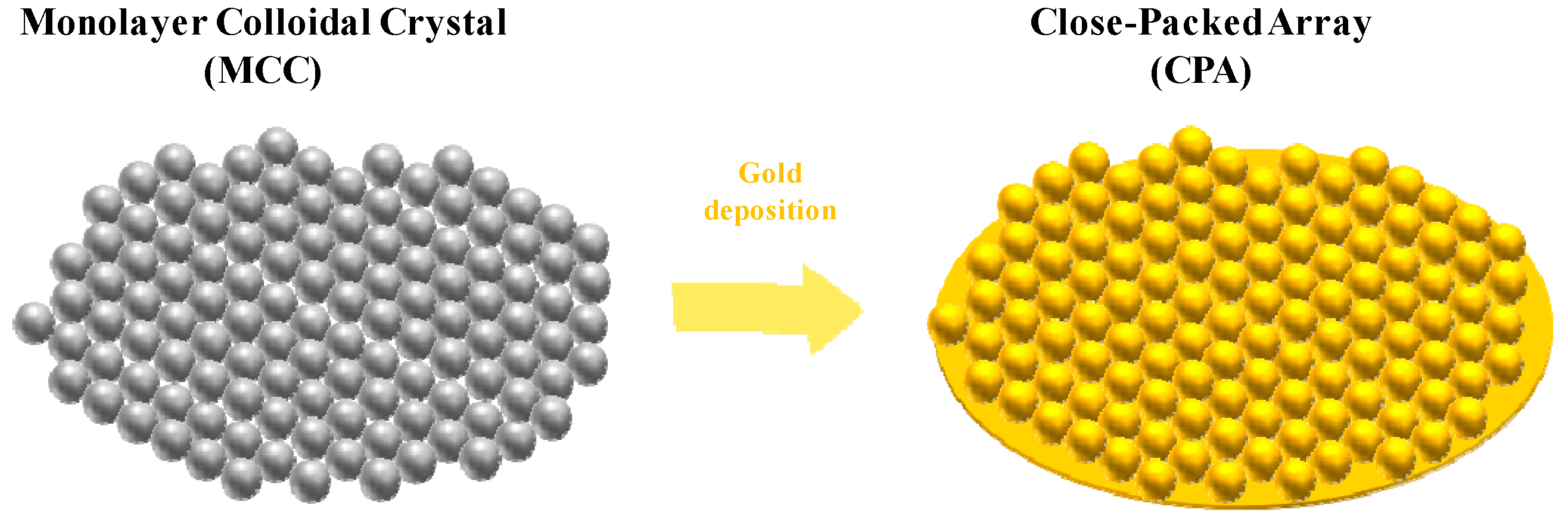

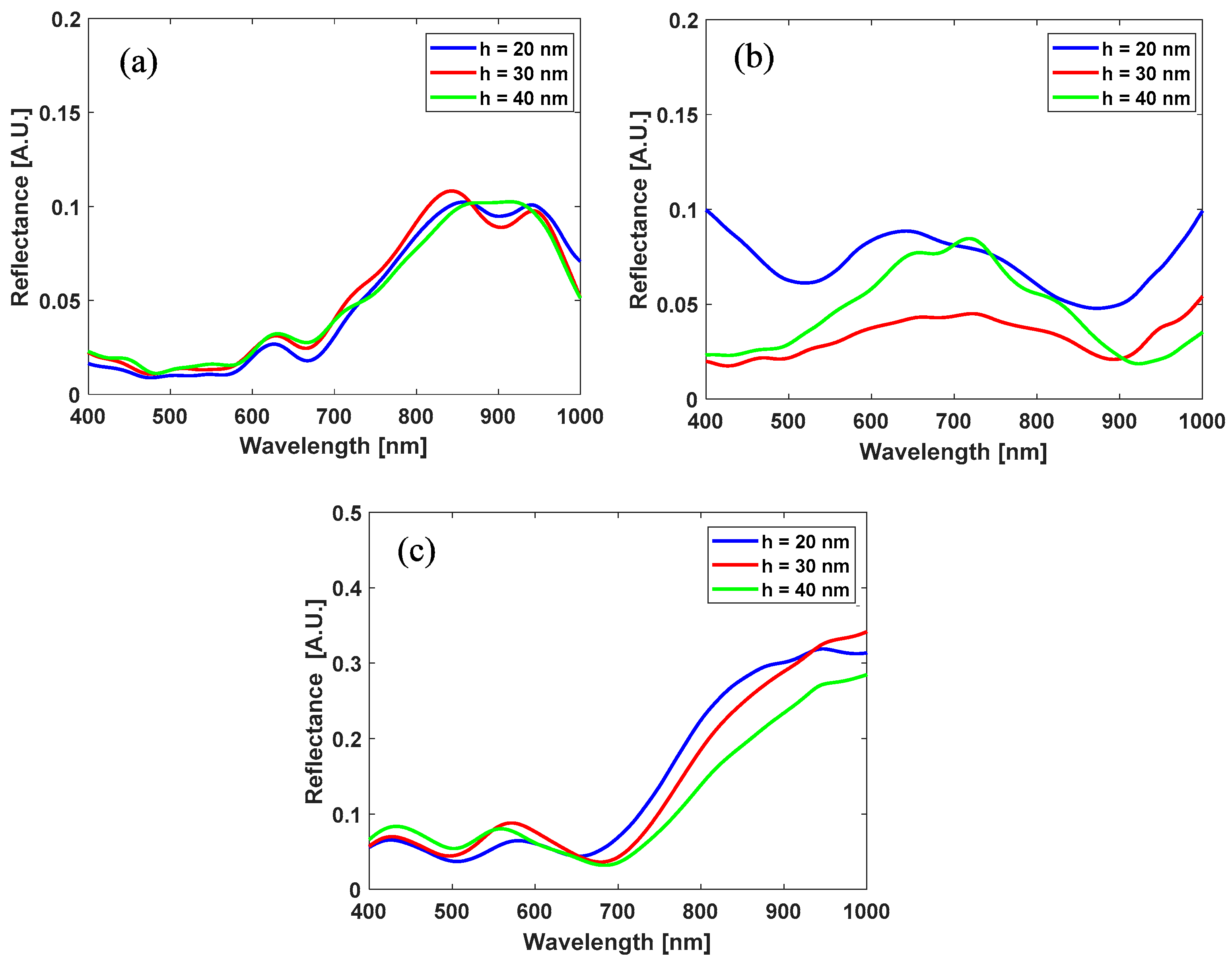

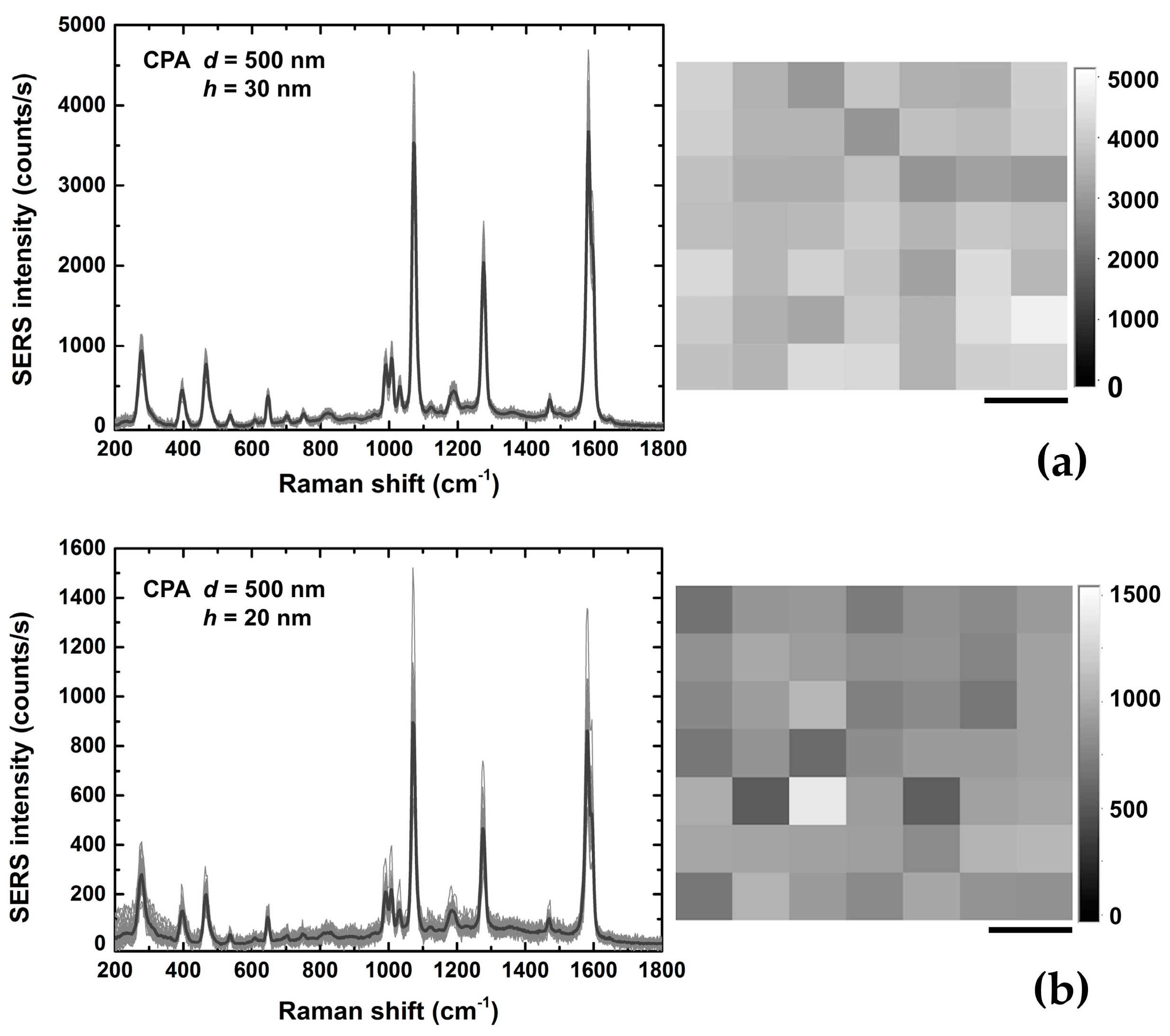
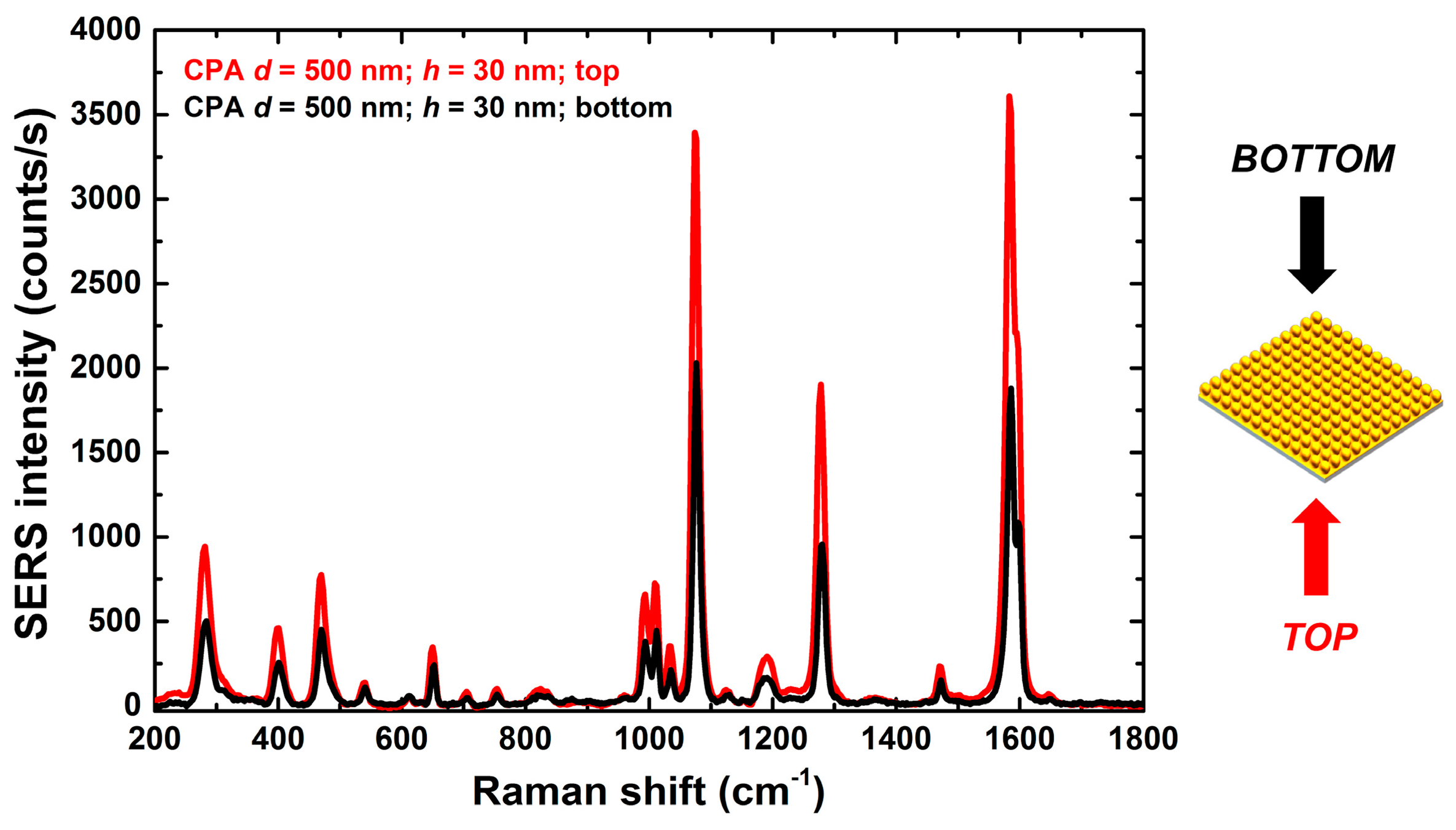
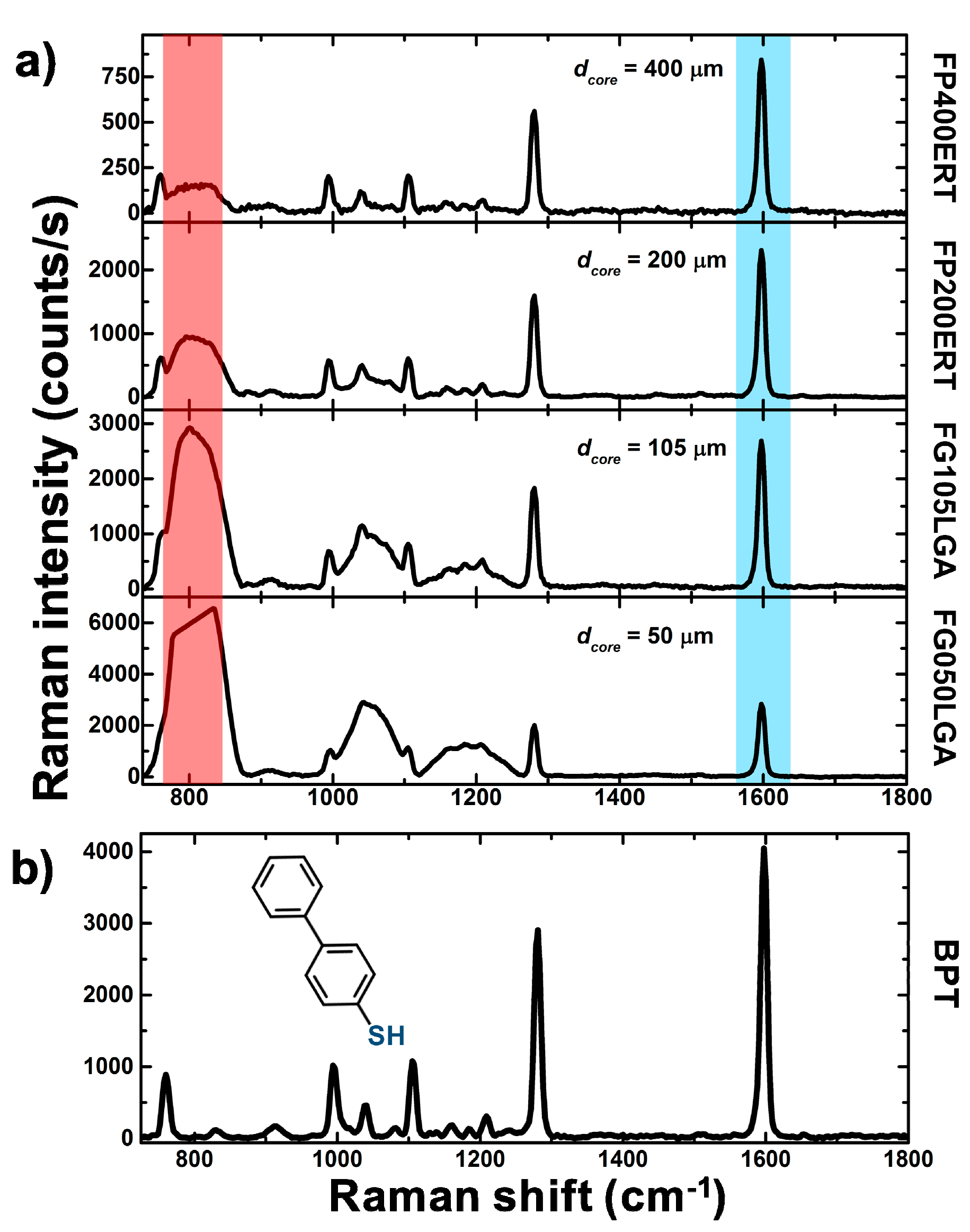
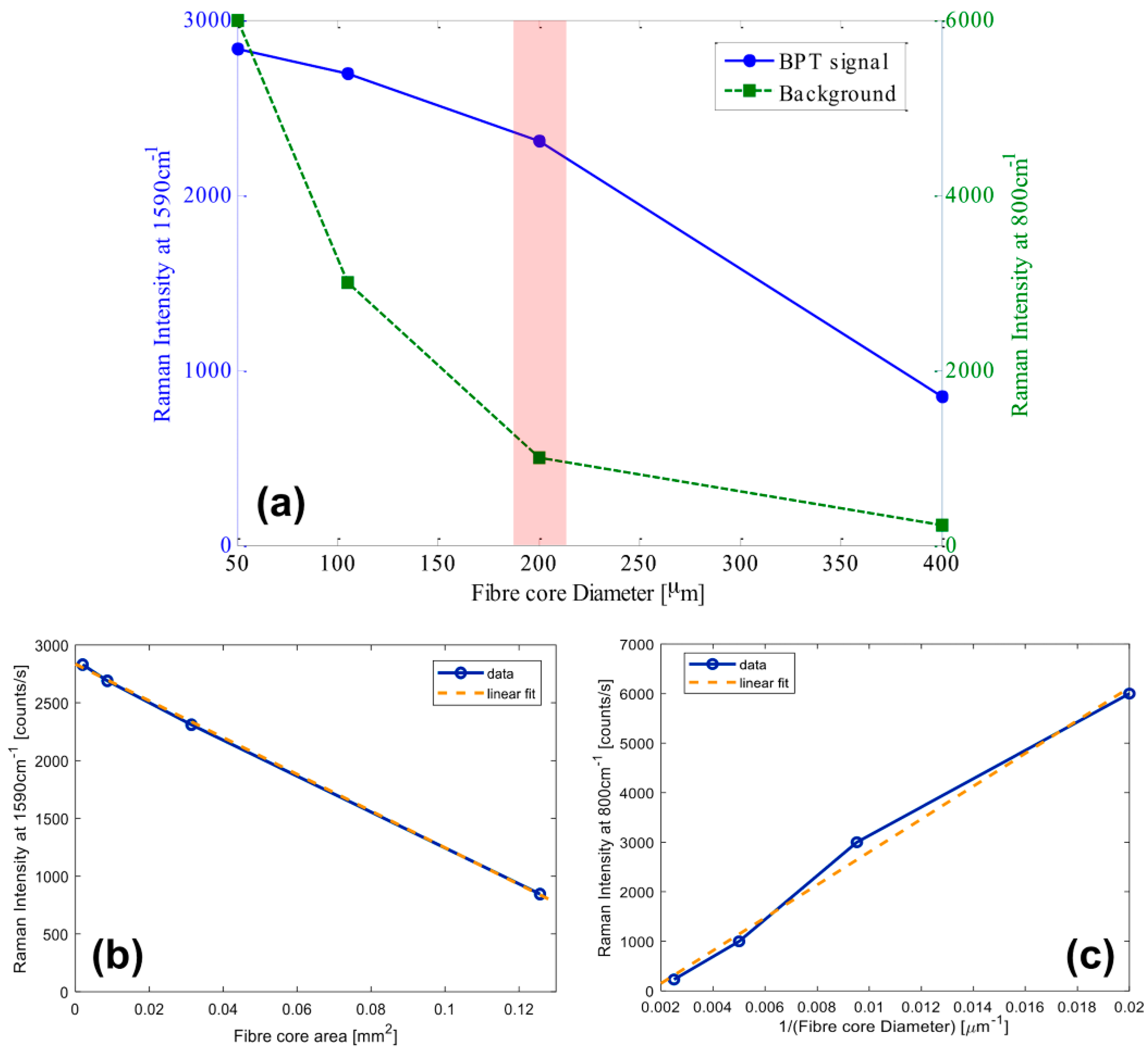
| Optical Fiber Type | Wavelength Range | Core Diameter | Optical Fiber Core Material | NA | Optical Fiber Cladding Material |
|---|---|---|---|---|---|
| FG050LGA [44] | 400–2400 nm | 50 µm | Pure silica (Low OH) | 0.22 | Fluorine-Doped Silica |
| FG105LCA [45] | 400–2400 nm | 105 µm | Pure silica (Low OH) | 0.22 | Fluorine-Doped Silica |
| FP200ERT [46] | 400–2200 nm | 200 µm | Pure silica (Low OH) | 0.5 | Hard Polymer |
| FP400ERT [47] | 400–2200 nm | 400 µm | Pure silica (Low OH) | 0.5 | Hard Polymer |
© 2018 by the authors. Licensee MDPI, Basel, Switzerland. This article is an open access article distributed under the terms and conditions of the Creative Commons Attribution (CC BY) license (http://creativecommons.org/licenses/by/4.0/).
Share and Cite
Quero, G.; Zito, G.; Managò, S.; Galeotti, F.; Pisco, M.; De Luca, A.C.; Cusano, A. Nanosphere Lithography on Fiber: Towards Engineered Lab-On-Fiber SERS Optrodes. Sensors 2018, 18, 680. https://doi.org/10.3390/s18030680
Quero G, Zito G, Managò S, Galeotti F, Pisco M, De Luca AC, Cusano A. Nanosphere Lithography on Fiber: Towards Engineered Lab-On-Fiber SERS Optrodes. Sensors. 2018; 18(3):680. https://doi.org/10.3390/s18030680
Chicago/Turabian StyleQuero, Giuseppe, Gianluigi Zito, Stefano Managò, Francesco Galeotti, Marco Pisco, Anna Chiara De Luca, and Andrea Cusano. 2018. "Nanosphere Lithography on Fiber: Towards Engineered Lab-On-Fiber SERS Optrodes" Sensors 18, no. 3: 680. https://doi.org/10.3390/s18030680







